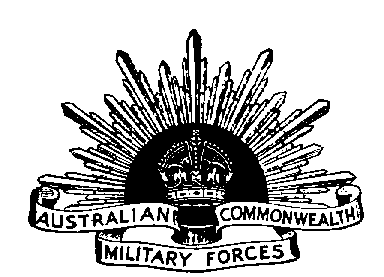

Godfrey George Howy Irving was born at the University of Melbourne on 25 August 1867, the son of Professor Martin Howy Irving. He was educated at Hawthorn Grammar. In 1886 he began working for McCulloch, Sellar & Co., a Melbourne firm.
While still at school, Irving enlisted in the 2nd Battalion, Victorian Rifles in 1885. He was commissioned as a lieutenant in the 2nd battalion in 1887 and in 1891 joined the Victorian Permanent Forces as a captain. Over the next nine years he was adjutant of the 1st, 2nd, 3rd, 4th and 5th Battalions. In March 1900 he became adjutant of the Victorian Rangers and was promoted to major in July 1900. In March 1902 he was appointed to the Victorian Headquarters staff in Melbourne.
Irving volunteered for service in South Africa and embarked in May 1902 as commander of the 6th Battalion, Australian Commonwealth Horse, with the temporary rank of lieutenant colonel. Four days after the battalion arrived in Natal, it was ordered to return owing to the end of the war. Irving returned to Australia and resumed duty on the Victorian staff.
In November 1903, he was transferred to the Army Headquarters staff.Irving was sent to England and India for training in 1905, returning in January 1906. In March 1906 he was posted to the Administrative and Instructional Staff in New South Wales. In September 1909 he became commandant of the 5th Military District (Western Australia). After some wrangling, Irving, was promoted to substantive lieutenant colonel along with majors H. G. Chauvel, J. G. Legge and V. C. M. Sellheim in December 1909. He was promoted to temporary colonel in January 1911 and substantive colonel on 1 May 1915. In July 1914, he moved to Adelaide to become Commandant of the 4th Military District (South Australia).
On 24 May 1915, Irving was appointed Chief of the General Staff, replacing Legge who had been appointed GOC AIF. His chief responsibility was overseeing the expansion of the training establishment in Australia to provide reinforcements for the AIF units overseas and raising and training what would become the 2nd Division.
By late 1915, the General Staff and the Minister of Defence, Hon. Senator G. F. Pearce, had become concerned over the way that the Australian Intermediate Base and the AIF training depot in Egypt were being run. Lacking confidence in the base commander, Colonel V. C. M. Sellheim, Pearce ordered Irving, an officer he regarded as more capable, determined and assertive than Sellheim, to take charge of the base in November 1915 as GOC Australian Troops in Egypt.
This assignment was overtaken by events. The evacuation of Gallipoli caused Birdwood's troops to return to Egypt, and Irving's appointment was altered to "GOC Australian Details and Reinforcements in Egypt". The details and reinforcements, however, were soon being drained away to form new units. Furthermore, on surveying the situation in Cairo, Irving felt that Sellheim had done a better job than had been recognised in Melbourne and praised his work to the minister. Accordingly, Sellheim promoted to brigadier general on 1 February 1916 and resumed command of the Intermediate Base on 19 February 1916.
Irving was instead given command of the 15th Infantry Brigade on 21 February 1916. On 1 March 1916, he was switched to command of the 14th Infantry Brigade. He was also acting commander of the 5th Division from 1 March until the arrival of Major General J. W. McCay from Australia on 22 March 1916. On 20 March, the 4th and 5th Divisions were ordered to move from their training area at Tel el Kebir to the Suez Canal, where they would replace the 1st and 2nd Divisions, which had recently left for France. The 8th Infantry Brigade and the 16th Battalion of the 4th travelled by train. The remainder were ordered to march across the desert.
A combination of recent typhoid inoculations, lack of physical condition, unsuitable clothing, new boots and high temperatures made the march a trying one for many of the troops. On 28 March, the second day of march, when the brigade halted for the midday break at 11am some of the men began to wander in search of water. Perhaps for this reason, Irving decided to recommence the march shortly after midday. On the recommendation of 5th Division headquarters, Irving made a detour away from some difficult sand hills towards a desert ridge which was supposed to afford a firmer surface. After an hour's marching in the noonday sun, the brigade reached the ridge where a halt was called in a state of utter exhaustion and many men collapsed of thirst and exhaustion. The brigade dissolved into a rabble and eventually staggered into camp at Moascar. The next day the Prince of Wales reviewed the formation and there were demonstrations of feeling against Irving. McCay judged Irving's arrangements for the march defective, relieved him of his command on 1 May 1916, replacing him with Lieutenant Colonel H. Pope of the 16th Battalion.
Irving returned him to Australia in June and once again became Commandant of the 4th Military District (South Australia).In February 1917, he became Commandant of the 1st Military District (Queensland). In May 1921 he was appointed Deputy Quartermaster General at Army Headquarters in Melbourne. He was placed on the unattached list in 1922 and made a major general on retirement in November 1925.
Irving died in Melbourne on 11 December 1937 and was buried in Boroondara Cemetery. His son Ronald Godfrey Howy Irving graduated from Royal Military College at Duntroon in 1919 and reached the rank of brigadier, while a daughter, Colonel Sybil Howy Irving was founder and Controller of the Australian Women's Army Service during World War II.
Sources: Australian Dictionary of Biography, 1899-1939, Vol 9, pp. 442-443; Bean, C. E. W., The Official History of Australia in the War of 1914-1918. Volume III: The AIF In France 1916, pp. 147-148, 288-291
Page created by Ross
Mallett
ross@metva.com.au
Last update 8 June 2010